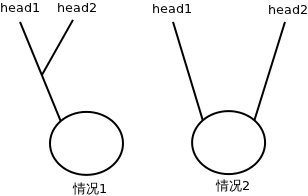这是一道广为流传的题目: 编程判断两个链表是否相交;原题假设“不带环”,所以只要想通了之后很简单;但是,若要考虑带环的情况,那么要注意的点就很多了。 其实可以把无环和有环的情况全都包括在一个方法实现内解决。
分析
首先,无环的情况;无环是《编程之美》原书里的题目,很多人都反应说这个题相对书中其它题来讲太过于简单了。也确实,只要在纸上把“所有单向链表相交的情况”画出来很容易就能想通解法了(只要正确理解题意,那么“两个无环单向链表”画出来只可能是2条不相干的链表或一个”Y”字形) —— 所以,判断两个不带环的链表是否相交,只要将两个链表的头指针都移到链表尾,然后比较尾指针地址是否相等就可以了。 如果带环,个人总结,要明白以下几点:
- 无环链表和有环链表是不可能相交的;
- 两个有环链表若相交,其“整个环上”的所有node一定都重合;
- 有环链表的相交,情况只有2种:相交于”环上”或相交于”不是环的部分”,即下图所示;两种情况都需要使用“两个指针的追逐”方法来判断两个链表的环部分是否相交;

- 有关链表追逐的考虑: 相对速度、距离、时间要算好,否则很容易漏掉几种边界情况;
代码
#include <stdio.h>
// define the node struct of links
typedef struct Node {
struct Node* next;
} Node;
int is_intersected(Node* p1, Node* p2);
Node* has_circle(Node* head);
int main(int args, char** argv) {
Node end1 = { NULL };
Node end2 = { NULL };
// 定义几种链表情况
// two links not intersect with each other, no circle
Node link_1_n =
{
&(Node) {&(Node) {&(Node) {&(Node) {&(Node) {&(Node) {&(Node) {&(Node) {&end1}}}}}}}}};
Node link_2_n =
{
&(Node) {&(Node) {&(Node) {&(Node) {&(Node) {&(Node) {&(Node) {&(Node) {&end2}}}}}}}}};
// two links intersect with each other, no circle
Node common_n = { &(Node) {&(Node) {&end1}}};
Node link_1_y = { &(Node) {&(Node) {&(Node) {&(Node) {&(Node) {&common_n}}}}}};
Node link_2_y = { &(Node) {&(Node) {&(Node) {&(Node) {&(Node) {&common_n}}}}}};
// two links, has circle, not intersected.
Node circle1 = { &(Node) {&(Node) {&(Node) {&(Node) {&circle1}}}}};
Node link_c1_n = { &(Node) {&(Node) {&(Node) {&(Node) {&circle1}}}}};
Node circle2 = { &(Node) {&(Node) {&(Node) {&(Node) {&circle2}}}}};
Node link_c2_n = { &(Node) {&(Node) {&(Node) {&(Node) {&circle2}}}}};
// two links, has circle, intersected at a non-circle position
Node common_c = { &(Node) {&(Node) {&(Node) {&(Node) {&common_c}}}}};
Node common_part = { &(Node) {&common_c}};
Node link_c1_y = { &(Node) {&(Node) {&common_part}}};
Node link_c2_y = { &(Node) {&(Node) {&common_part}}};
// two links, has common circle, but different 'joint-points'.
Node jp1 = { NULL };
Node jp2 = { NULL };
// 'weave' the joint-points into a circle:
jp1.next = &(Node) {&(Node) {&jp2}};
jp2.next = &(Node) {&jp1};
Node link_c1_y2 = { &(Node) {&(Node) {&(Node) {&(Node) {&jp1}}}}};
Node link_c2_y2 = { &(Node) {&(Node) {&(Node) {&(Node) {&jp2}}}}};
if (is_intersected(&link_1_n, &link_2_n)) {
printf("link_1_n and link_2_n Intersected!\n");
}
if (is_intersected(&link_1_y, &link_2_y)) {
printf("link_1_y and link_2_y Intersected!\n");
}
if (is_intersected(&link_c1_n, &link_c2_n)) {
printf("link_c1_n and link_c2_n Intersected!\n");
}
if (is_intersected(&link_c1_y, &link_c2_y)) {
printf("link_c1_y and link_c2_y Intersected!\n");
}
if (is_intersected(&link_c1_y2, &link_c2_y2)) {
printf("link_c1_y2 and link_c2_y2 Intersected!\n");
}
return 0;
}
int is_intersected(Node* p1, Node* p2) {
Node* has_circle_1 = has_circle(p1);
Node* has_circle_2 = has_circle(p2);
if (has_circle_1) {
if (has_circle_2) {
Node* pp1 = has_circle_1;
Node* pp2 = has_circle_2;
if (pp1 == pp2 || pp1->next == pp2)
return 1;
while (pp1->next != has_circle_1) {
pp1 = pp1->next;
pp2 = pp2->next->next;
if (pp1 == pp2)
return 1;
}
return 0;
} else {
return 0;
}
} else {
if (has_circle_2) {
return 0;
} else {
while (p1->next)
p1 = p1->next;
while (p2->next)
p2 = p2->next;
return p1 == p2;
}
}
return 0;
}
Node* has_circle(Node* head) {
Node* p1;
Node* p2;
p1 = p2 = head;
if (p2->next != NULL) {
p2 = p2->next;
} else {
return NULL;
}
while (p2->next != NULL && p2->next->next != NULL) {
p1 = p1->next;
p2 = p2->next->next;
if (p1 == p2)
return p1;
}
return NULL;
}
其中,has_circle方法是判断一个单向链表是否带环的,基本原理就是设置2个“速度”不同的链表,快的去追慢的,追上就是带环,直到较快指针遇到null还没追上就是没有环;假设环包含n个节点,指针p2的”速度”是2,p1的速度是1,相对速度就是1,从相同一点出发的话,p2追上p1至少要n步;若再假设该链表除了环的部分外还带有一个长度为k的“尾巴”,那么追上的步数最多是n+k;也就是线性时间复杂度内就能完成这个判断。
这提供了一种很好的判断是否”环状”的思路;以前我只写过“用一个栈来记录”的方式,弱爆了…(时间复杂度为O(n2))
在has_circle_1和has_circle_2都满足的时候,也就是说2个链表都带环的时候,要分别取2个环上的一点来玩“追逐游戏”来判断是否相交;在这段程序里是pp1和pp2;然后一个速度为2一个速度为1开始玩“追逐游戏”,当慢的那个走完环上所有节点时快的那个还没追上它的话,说明不相交(此时耗费时间n——即环节点数;因为快慢指针的相对速度为1,快指针理应在时间n以内追上慢链表,否则不相交)。
总结
单向链表的问题…着实不简单,可以相当复杂…对于这种关乎“形状”的问题,在纸上画一画会很有帮助。